1902 Clover Leaf Egg and its missing surprise
While working on the identifying of the possible surprise to the 1907 Rose Trellis Egg, I noticed the Empress in the same photo wearing a brooch or pin that resembled a four-leaf clover. Imperial Egg lovers know what that means, the surprise to the 1902 Clover Leaf Egg. Could it be? Or is this just too good to be true?
On the other hand, the same goes here as with the 1907 Rose Trellis Medallion, how many four-leaf clover jewels with miniatures could the Empress have had in 1908? And was she not only wearing a portrait of her only son, but of all her five children that day in June 1908?
Below is the image of the Empress Alexandra Feodorovna while visiting Reval (now Tallinn, Estonia) in 1908. This visit was besides a state visit, a family meeting too as the Russian and British Royals were closely connected. She is wearing what my fellow researcher Greg Daubney and I think is the medallion that was the surprise from the 1907 Rose Trellis Egg. See that story here.
Now quick forwards, or better backwards, to the 1902 Clover Leaf Egg.
As you can see from the pictures below, we need a little help. The image is too unclear and vague to even see if the jewel the Empress is wearing possibly could be by Fabergé. Yet the more I look at the pictures, the more I think I see at least three portraits on the leaves of the clover, I even see the leaves bordered by diamonds. And with a little bit of imagination, I even see the faces of (the Imperial) children...
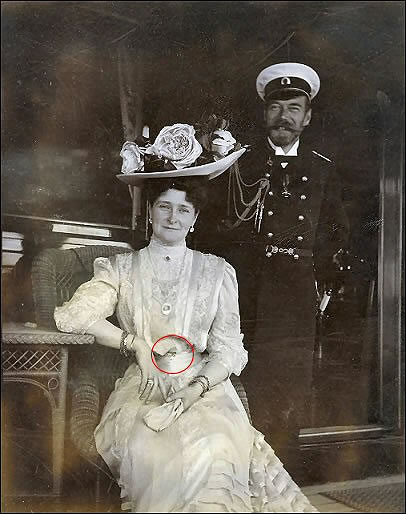
(Photo courtesy Humus777) Click image to see large version.
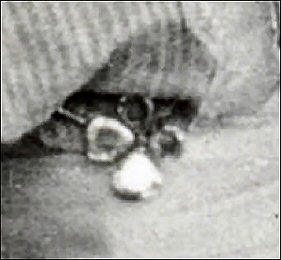
(Enlargement of the jewel the Empress is wearing)
In 1902 when the Clover Egg was presented, the Imperial couple had four children, the youngest Anastasia being born in June 1901. The four daughters were immortalized in paint on a miniature in a wooden (Fabergé ?) frame. This frame Greg Daubney found on the internet. I could not track it down to a real source, only found it on Pinterest. The postcard to the right of the frame, is an official photograph made by L. Levitsky on August 16, 1901. The postcard I found on Les Derniers Romanov.com under 1901. When you click the photo on that page, you will get a larger version and can read the text.
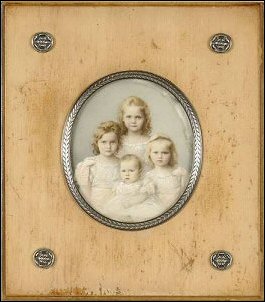 x
x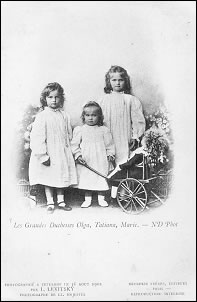
I think that the miniature in the wooden frame above, is based on the 1901 photograph, with baby Anastasia added to the miniature, as she was too young (two months) when the official photo was made.
I think the same photograph was used for the miniatures in the brooch, or pin the Empress used the four-leaf clover for. From the 1899 Pansy Egg, we know that Fabergé was capable of making these extremely small miniatures.
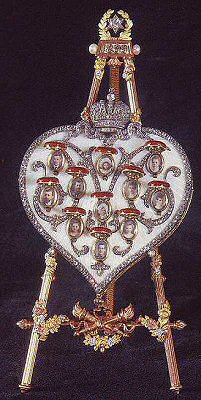
(Miniatures on the Surprise of the 1899 Pansy Egg)
Fabergé scholar Ulla Tillander-Godenhielm wrote me about the jewels the Empress is wearing on this occasion: It is more than logical that the empress could not 'favourize' one of her children, albeit the boy was the long-awaited heir to the throne. Of course she would also wear a jewel linked to her four daughters on this state visit!
The Reval visit was a 'family' visit in the sense that the visitors were the closest relatives of the imperial family and the conversation naturally to a great extent would have been news about the children. Alexandra had very good taste in both costumes and in the smart way of wearing jewellery - how elegant to wear the four clover brooch at the waistline! These pieces of jewellery were real 'conversation pieces', immediately sparking off delightful comments and admiration centered on the children.
Thus, I think we now know more or less what the surprise to the 1902 Clover Egg looked like, but as I said, you have to have some imagination and unless we find a real good picture of the Empress wearing the same four-leaf clover, or even better the jewel itself, we will never know.
Therefore we need help from the public, from you, Romanov and Fabergé lovers. We are searching for a good image of a four-leaf clover, preferably by Fabergé, with 23 diamonds, rose-cut diamonds and 4 miniatures, as was written down by Fabergé on the invoice for the 1902 Imperial Easter Egg.
Your reward will be eternal gratitude from all Fabergé Imperial Egg lovers!
Update January 2019
At Christies in London, in November 2018, a jewelled and guilloché enamel gold brooch in the form of a four-leaf clover, by Fabergé with the workmaster's mark of Mikhail Perkhin was sold. The design looks very familiar to the jewel the Empress was wearing in Reval in 1908 and perhaps a clue that the brooch or pin was indeed made by Fabergé.
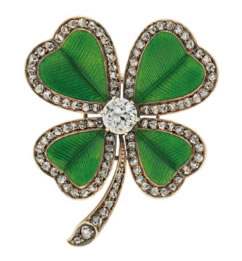
Four-leaf Clover Brooch by Fabergé (Courtesy Christies)
Annemiek Wintraecken, with help from Greg Daubney
Page made November 4, 2017
Update summer 2019 -1902 Clover Leaf Egg Surprise Identified? A Team Effort.
![]() In this essay, two Fabergé enthusiasts provide tantalizing information about this surprise. (First published in the Fabergé Research Newsletter, Spring-Summer 2019). All images in this essay, courtesy Fabergé Research Newsletter.
In this essay, two Fabergé enthusiasts provide tantalizing information about this surprise. (First published in the Fabergé Research Newsletter, Spring-Summer 2019). All images in this essay, courtesy Fabergé Research Newsletter.
Annemiek Wintraecken (The Netherlands) writes: In October 2017, Fabergé egg enthusiast Greg Daubney from the United Kingdom sent me a photograph of Empress Alexandra Feodorovna wearing a medallion around her neck. He suggested it might be the missing surprise (later identified with a portrait of the Tsesarevich Alexis) for the 1907 Rose Trellis Egg. While studying this image, I noticed the Empress was also wearing a brooch or pin resembling a four-leaf clover on her waist cummerbund. Could it be the missing surprise for another egg, the 1902 Clover Leaf Egg by Fabergé? How many four-leaf clover jewels with four tiny portraits could the Empress have owned? Unfortunately, the enlarged image was unclear and too vague to determine if the jewel was by Fabergé, but the more I looked at the object, the more I realized there were at least four miniature portraits on clover leaves bordered by diamonds. And with a little bit of imagination one can even see the faces of the four daughters of the Imperial couple, Emperor Nicholas II and his wife, Alexandra Feodorovna.

Juan F. Déniz (Gran Canaria, Canary Islands) writes: In June 2018, I found an illustration of a clover leaf in an article entitled “Unscrambled Eggs” by Geoffrey Munn1 with this caption: “An undated design for a jewel in the form of a four-leaf clover set with diamonds. Each leaf has an open aperture, probably for miniatures or photographs. From the Holmström Archive. Wartski, London.” I recalled Annemiek Wintraecken’s research on the 1902 Clover Leaf Egg and her hypothesis about the missing surprise, both discussed on her website.

I was not certain the ornament was created by Fabergé, since brooches or similar jewels in the form of a clover were a fashionable accessory for women during Fabergé’s time. After lining up the design sketch next to the enlarged brooch or pin in the shape of a clover leaf worn by the Empress in 1908, the similarity became apparent based on the different sizes of the leaves and their shapes. Is Holmström’s design sketch the prototype for Alexandra’s accessory?
Tatiana Muntian in her essay in the exhibition catalog for the first major Fabergé exhibition in the former Soviet Union in 19893 states:
“The ‘surprise’ of the Clover Egg from the Kremlin is lost but some archive papers make it clear that there was a large ‘clover leaf of four foils with 23 diamonds, roses and four miniature portraits.’ One may only guess that the portraits were those of [the] Tsar’s daughters. …” Muntian concludes with an explanation of the symbolic meaning of the four-leaf clover or quatrefoil.
The 1902 Egg is included without its surprise in the detailed 1909 inventory of the Imperial family’s private apartments by Nikolai Dementiev, inspector of the premises of the Winter Palace. Was the surprise “in use” by the Empress as a piece of jewelry to be worn? The Clover Egg with its stand is just 3 7/8 in. (9.8 cm) in height, so its surprise had to be quite small. Illustrated below are the prongs for the surprise:

The authors contacted Geoffrey Munn, managing director emeritus, Wartski, London, with their hypothesis. His response was as follows:
“As I said in the article the quatrefoil is, for obvious reasons, a very popular device in 19th and early 20th century. It not only stands for luck in love, but is well established in Christian lore. However, since the surprise is missing and there is a quatrefoil worn by the Empress there is every reason to think this is the very one. Bravo for the discovery to both Juan and you!”
An effort to find the surprise pictured in auction catalogs from 1934 to the present has not yielded any results. A quatrefoil dated 1890, without spaces for photographs and yet similar to the Holmström design sketch was made in the Mikhail Perkhin workshop. It sold at auction, Christie’s London, November 26, 2018, Lot 208. (See above, update January 2019).
The essay above was written for and first published in the Fabergé Research Newsletter, Spring-Summer 2019. The original article has additional images you might like to see (here).
Page updated or corrected: December 10, 2019
